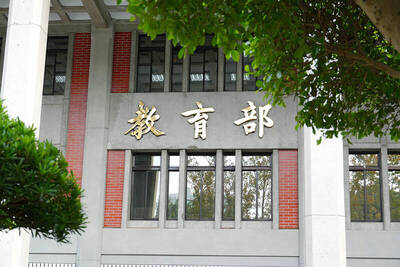■Crime
Police intercept gun shipment
A large shipment of contraband firearms was discovered over the weekend in a container aboard a Panama-registered cargo ship at Kaohsiung Harbor, prosecutors said yesterday. Acting on a tipoff, investigators intercepted the Consistence after the container vessel arrived at Kaohsiung Harbor from the Philippines Saturday evening. Investigators opened a container aboard the ship and discovered eight large cases containing a number of firearms, including two military-issue M-16 rifles, five submachine guns, 43 pistols of various brands and 6,059 rounds of ammunition. Among the ammunition were shotgun cartridges and dum-dum bullets. "The serial numbers of the two rifles had been removed in an apparent attempt to block any tracing of their origins," said Wang Tze-min, a secretary with the Investigation Bureau's Kaohsiung Harbor office. "Based on this finding, we suspect that some military or government officials in the rifles' country of origin might be involved in the illegal gun trafficking," he added. As most of the firearms were wrapped in Philippine newspapers, Wang said he is almost certain that they were shipped from there.
■ Cross-strait ties
Ma pushes Sungshan flights
Sungshan Airport could be used as the country's representative airport once direct air links across the Taiwan Strait are opened, Taipei Mayor Ma Ying-jeou (馬英九) said yesterday. Ma said the Taipei City Government will not only continue to push for the opening of direct air links, but it will also suggest that Sungshan Airport be used along with Shanghai's Hongqiao Airport to provide convenient service for Taiwanese businesspeople working in China. Noting that Sunday's opening of indirect chartered flights between CKS International Airport and Shanghai's Pudong Airport was as a mere "contingent and temporary" approach, Ma said direct Sungshan-to-Hongqiao flights would be a much more practical and realistic approach.
■ Tourism
Sapporo flights now regular
A charter flight service between Taipei and Sapporo has been upgraded to regular flights, the Ministry of Foreign Affairs (MOFA) said yesterday. MOFA officials said that -- after long-term efforts and several rounds of consultations with Japan -- the president of Taiwan's Association of East Asian Relations, Hsu Shui-teh (許水德), and the president of Japan's Interchange Association, Rejiro Hattori, signed an aviation agreement on behalf of their respective governments last Thursday, which became effective the same day. Sapporo became the fifth destination in Japan after Tokyo, Osaka, Nagoya, and Fukuoka to which Taiwan air carriers maintain regular flights.
■ Education
PRC-university texts OK'd
The Mainland Affairs Council has agreed to allow the sale of Chinese university textbooks, an official said yesterday. The official said that initially only academic books will be allowed in. "We'll decide later whether to allow entry of other categories of books in the future," the official said. Advisers to the council have also endorsed a proposal to allow local publishers to publish Chinese magazines printed in traditional Chinese characters. Publishers must obtain government approval, plus legal authorization from their Chinese counterparts. University officials said they do not think that the measure will have much of an impact on local campuses.

The Ministry of Education (MOE) is to launch a new program to encourage international students to stay in Taiwan and explore job opportunities here after graduation, Deputy Minister of Education Yeh Ping-cheng (葉丙成) said on Friday. The government would provide full scholarships for international students to further their studies for two years in Taiwan, so those who want to pursue a master’s degree can consider applying for the program, he said. The fields included are science, technology, engineering, mathematics, semiconductors and finance, Yeh added. The program, called “Intense 2+2,” would also assist international students who completed the two years of further studies in

The brilliant blue waters, thick foliage and bucolic atmosphere on this seemingly idyllic archipelago deep in the Pacific Ocean belie the key role it now plays in a titanic geopolitical struggle. Palau is again on the front line as China, and the US and its allies prepare their forces in an intensifying contest for control over the Asia-Pacific region. The democratic nation of just 17,000 people hosts US-controlled airstrips and soon-to-be-completed radar installations that the US military describes as “critical” to monitoring vast swathes of water and airspace. It is also a key piece of the second island chain, a string of

Taiwan will now have four additional national holidays after the Legislative Yuan passed an amendment today, which also made Labor Day a national holiday for all sectors. The Chinese Nationalist Party (KMT) and Taiwan People’s Party (TPP) used their majority in the Legislative Yuan to pass the amendment to the Act on Implementing Memorial Days and State Holidays (紀念日及節日實施辦法), which the parties jointly proposed, in its third and final reading today. The legislature passed the bill to amend the act, which is currently enforced administratively, raising it to the legal level. The new legislation recognizes Confucius’ birthday on Sept. 28, the

A magnitude 5.9 earthquake that struck about 33km off the coast of Hualien City was the "main shock" in a series of quakes in the area, with aftershocks expected over the next three days, the Central Weather Administration (CWA) said yesterday. Prior to the magnitude 5.9 quake shaking most of Taiwan at 6:53pm yesterday, six other earthquakes stronger than a magnitude of 4, starting with a magnitude 5.5 quake at 6:09pm, occurred in the area. CWA Seismological Center Director Wu Chien-fu (吳健富) confirmed that the quakes were all part of the same series and that the magnitude 5.5 temblor was